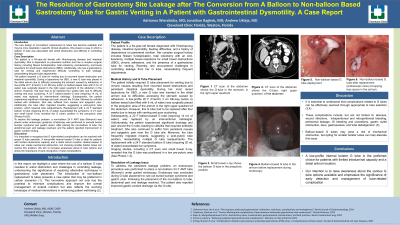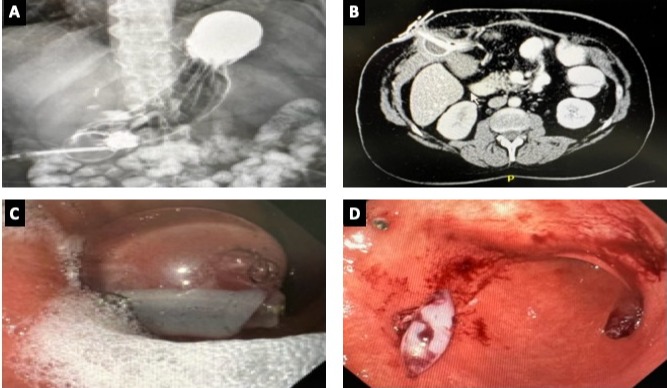Sunday Poster Session
Category: Stomach
P1374 - The Resolution of Gastrostomy Site Leakage After the Conversion from a Balloon to Non-balloon Based Gastrostomy Tube for Gastric Venting in a Patient with Gastrointestinal Dysmotility: A Case Report
Sunday, October 22, 2023
3:30 PM - 7:00 PM PT
Location: Exhibit Hall

Has Audio

Adrianna Wierzbicka, MD
Cleveland Clinic Florida
Weston, FL
Presenting Author(s)
Adrianna Wierzbicka, MD, Jonathan Ragheb, MD, Andrew Ukleja,
Cleveland Clinic Florida, Weston, FL
Introduction: The new design non-balloon replacement G tubes became available and may be more desirable in certain scenarios. We present a case in which a balloon G tube was associated with antral obstruction and difficulty in controlling leakage.
Case Description/Methods: The patient is a 64-year old female with Hirschsprung disease, intestinal dysmotility, dependance on parenteral nutrition, complex surgical history including Nissen fundoplication, total colectomy, end-ileostomy, bowel resections for small bowel obstructions (SBO), and a gastrostomy tube for venting who had difficulty controlling G tube leakage and needed frequent tube adjustments.
The patient required G tube placement for venting due to recurrent bowel obstruction and intestinal dysmotility. At the time of laparotomy for SBO, a new G tube was placed in the distal antrum due to difficulty accessing the stomach from adhesions. The low profile 20 F (French) 3 cm Mic-key button (balloon-based tube with 6 mL of water) was placed surgically in the right upper quadrant of the abdomen in the antrum. This tube was replaced 4 weeks later due to difficulty venting and poor suctioning. A 22 F balloon-based G tube (requiring 14 mL of water) was replaced by interventional radiology. The patient developed significant drainage and pain around the G tube, followed by cellulitis treated with antibiotics. She also suffered from nausea and epigastric pain. In addition, the tube often migrated inwards suggesting post-pyloric tube position which required tube readjustments. Replacement with 24 F standard balloon G tube (20 mL of water) made the symptoms even worse. The CT scan and small bowel X-ray revealed G tube position in pre-pyloric area. (Photos A & B) To resolve this leakage problem, a non-balloon 24 F AMT tube (Monarch) was placed under endoscopic guidance. Endoscopy was done to exclude buried bumper syndrome and gastric ulcers. After placing the non-balloon G tube, the abdominal pain and leakage resolved. The patient also reported improvement in gastric content venting.
Discussion: It is important to recognize that G tube-related complications can be resolved with a proper G tube selection. A low-profile internal bolster G tube is ideal for patients with limited intraluminal capacity and distal antrum location. Balloon-based G tubes can create mechanical obstruction and the choice of small bolster tubes can resolve this problem. We wanted to increase awareness about G tube options and the importance of early recognition of tube complications.

Disclosures:
Adrianna Wierzbicka, MD, Jonathan Ragheb, MD, Andrew Ukleja, . P1374 - The Resolution of Gastrostomy Site Leakage After the Conversion from a Balloon to Non-balloon Based Gastrostomy Tube for Gastric Venting in a Patient with Gastrointestinal Dysmotility: A Case Report, ACG 2023 Annual Scientific Meeting Abstracts. Vancouver, BC, Canada: American College of Gastroenterology.
Cleveland Clinic Florida, Weston, FL
Introduction: The new design non-balloon replacement G tubes became available and may be more desirable in certain scenarios. We present a case in which a balloon G tube was associated with antral obstruction and difficulty in controlling leakage.
Case Description/Methods: The patient is a 64-year old female with Hirschsprung disease, intestinal dysmotility, dependance on parenteral nutrition, complex surgical history including Nissen fundoplication, total colectomy, end-ileostomy, bowel resections for small bowel obstructions (SBO), and a gastrostomy tube for venting who had difficulty controlling G tube leakage and needed frequent tube adjustments.
The patient required G tube placement for venting due to recurrent bowel obstruction and intestinal dysmotility. At the time of laparotomy for SBO, a new G tube was placed in the distal antrum due to difficulty accessing the stomach from adhesions. The low profile 20 F (French) 3 cm Mic-key button (balloon-based tube with 6 mL of water) was placed surgically in the right upper quadrant of the abdomen in the antrum. This tube was replaced 4 weeks later due to difficulty venting and poor suctioning. A 22 F balloon-based G tube (requiring 14 mL of water) was replaced by interventional radiology. The patient developed significant drainage and pain around the G tube, followed by cellulitis treated with antibiotics. She also suffered from nausea and epigastric pain. In addition, the tube often migrated inwards suggesting post-pyloric tube position which required tube readjustments. Replacement with 24 F standard balloon G tube (20 mL of water) made the symptoms even worse. The CT scan and small bowel X-ray revealed G tube position in pre-pyloric area. (Photos A & B) To resolve this leakage problem, a non-balloon 24 F AMT tube (Monarch) was placed under endoscopic guidance. Endoscopy was done to exclude buried bumper syndrome and gastric ulcers. After placing the non-balloon G tube, the abdominal pain and leakage resolved. The patient also reported improvement in gastric content venting.
Discussion: It is important to recognize that G tube-related complications can be resolved with a proper G tube selection. A low-profile internal bolster G tube is ideal for patients with limited intraluminal capacity and distal antrum location. Balloon-based G tubes can create mechanical obstruction and the choice of small bolster tubes can resolve this problem. We wanted to increase awareness about G tube options and the importance of early recognition of tube complications.

Figure: A. Small bowel x-ray shows the balloon G-tube in the prepyloric position; B. CT scan of the abdomen shows the G-tube in the stomach, right upper quadrant; C. Balloon-based G tube in the antrum before replacement during endoscopy; D. Non-balloon-based G tube after replacement (endoscopic view) occupying less space in the antrum.
Disclosures:
Adrianna Wierzbicka indicated no relevant financial relationships.
Jonathan Ragheb indicated no relevant financial relationships.
Andrew Ukleja indicated no relevant financial relationships.
Adrianna Wierzbicka, MD, Jonathan Ragheb, MD, Andrew Ukleja, . P1374 - The Resolution of Gastrostomy Site Leakage After the Conversion from a Balloon to Non-balloon Based Gastrostomy Tube for Gastric Venting in a Patient with Gastrointestinal Dysmotility: A Case Report, ACG 2023 Annual Scientific Meeting Abstracts. Vancouver, BC, Canada: American College of Gastroenterology.
